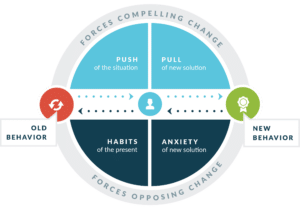If you’re like millions of Americans, at some point in your life you’ve resolved–then failed–to lose weight, exercise more, drink less or quit smoking. Perhaps you’ve also bailed on a physical therapy regime, or quit taking a prescribed medication mid-course. You may even have passed on potentially life-saving disease screenings. Why, when we know what’s good for our health, do we often have such a hard time doing it?
The Theory of Jobs to Be Done, based on our research into consumer purchasing behavior, provides some insight. Jobs Theory explains that everything people consciously choose to do (including doing nothing), they do to make progress according to their own goals, in a particular set of circumstances. We call this progress a “job,” and it motivates individuals to search for solutions.
Applied to healthcare, Jobs Theory explains that any one job can have multiple solutions, and these, in turn, can have health detracting, promoting or neutral qualities. For instance, a man with the job, “bond with my colleagues” could “hire” after work drinks (health detracting), a slot on the company charity 10k team (health promoting), or a role on the team event-planning committee (health neutral). So providers can make it easier for patients to act in the best interests of their health by designing treatments and regimes that perform important life jobs for them.
Jobs Theory also tells us that a proposed solution’s “job performance” is not the only factor influencing consumers’ hiring decisions. In Competing Against Luck, Professor Clayton Christensen and co-authors explain that there are two types of forces battling for dominance in a consumer’s moment of choice: those compelling the adoption of a new solution, and those opposing it.
The forces compelling change include the push of the situation, or the size of the problem a consumer wants to solve, and the pull, or attractiveness, of the new solution purporting to solve it. Both these forces must reach a certain threshold of materiality to compel change. For instance, a problem that is merely inconvenient or annoying will not, on its own, drive someone to seek and embrace a new solution. And if consumers can’t see exactly how a solution will help them make progress that improves their lives, it won’t even make their consideration set.
The forces opposing change include allegiance to current behavior, otherwise known as the “habit of the present,” and anxieties about adopting new solutions, which accompany even the most compelling solutions. The list of potential anxieties—cost, learning requirements, or the simple specter of the unknown—is almost endless, and often overwhelming.
One important reason habits of the present block change is because people’s psychological aversion to loss is twice as powerful as their attraction to gains, as first demonstrated by psychologists Daniel Kahneman and Amos Tversky. Giving up on routines and “tried and true” solutions most definitely represents a loss.
In fact, anxiety about “firing” a status quo solution often proves a formidable barrier to change. Yet rather than addressing it, innovators typically focus their efforts on strengthening the pull, or attractiveness, of a new solution. In doing so, they risk succumbing to the magical-thinking of “build it and they will come.”
Astute observers of human behavior can detect the anxiety of firing the status quo in consumers grappling with decisions ranging from the truly life-changing—such as choice of disease treatment, educational path, or home purchase—to the utterly mundane, such as whether or not to purchase a mattress.
Marie Kondo, author of The New York Times Best Seller, The Life-Changing Magic of Tidying Up, is one such observer. Her “KonMari method” of decluttering homes has become an international sensation precisely because it recognizes people’s surprising, almost embarrassing anguish about discarding possessions they no longer want, and offers them a remarkably simple solution for overcoming it. Kondo writes,
“People have trouble discarding things that they could still use (functional value), that contain helpful information (informational value), and that have sentimental ties (emotional value). When these things are hard to obtain or replace (rarity), they become even harder to part with.”
[But] “To get rid of what you no longer need is neither wasteful nor shameful. Can you truthfully say that you treasure something buried so deeply in a closet or drawer that you have forgotten its existence? If things had feelings, they would certainly not be happy…Help them leave that deserted isle to which you have exiled them. Let them go, with gratitude. Not only you, but your things as well, will feel clear and refreshed when you are done tidying.”
Kondo relieves people’s anxiety about discarding items they no longer want, but which retain some kind of value, by cleverly re-positioning the “firing” process as a gracious retirement ceremony in which they thank their possessions for excellent service.
The method is undoubtedly unconventional, but it obviously speaks to millions of people around the world who have read Kondo’s book, watch her television show, and pay for her consulting services. And its success reinforces a critical fact about healthcare innovation: it’s not enough to create a health solution that nails a patient’s Job to Be Done.
Providers must understand precisely how the forces of progress are acting on the patient seeking solutions for that job. They then need to create an end-to-end adoption and adherence process for the health solution that nets out in a “hire” decision by the patient, given the strength with which the different forces are blowing. This may sound like a very difficult task. But with clear insight into people’s jobs and circumstances, it’s possible. Echoing the words of Mari Kondo, you might even call it “everyday magic.”
For more on innovation in healthcare delivery, including the “forces of change,” see:
Health for hire: Unleashing patient potential to decrease chronic disease costs.



